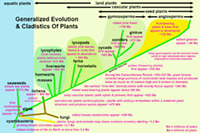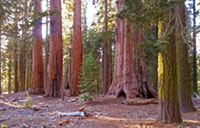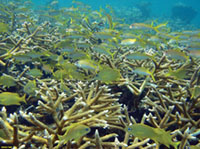2.29: Evolution and Adaptation To Extremes
- Page ID
- 9798
Evolution and Adaptation To Extremes
Adaptation is the driving force of evolution on many levels (microscopic to massive organisms; individual species to diverse communities). Environmental changes over time force species and communities (ecosystems) to adapt to special niches. Figure 2.75 shows the evolution and diversification of plants through geologic time. Some species able to spread across large regions by adapting to variable climate conditions that match their reproductive and feeding cycles. Ancient lineages that have survived extinction are often better adapted to living in harsh environments (such as lichens, mosses, and club mosses living in barren, rocky settings, Figure 2.76). Species like the Giant Sequoias that live in isolated communities in California's Sierra Nevada Range are remnant populations was once a much more widespread forest community that existed during the last ice age (Figure 2.77).
Organisms that have adapted to living in vernal pools illustrate adaptation to extreme environmental conditions. A vernal pool is a small pool or pond that forms temporarily, such as after a summer thunderstorm, seasonal precipitation (Figure 2.79). During a short period when water is present, a variety of species have adapted to completing their entire life cycle in a matter of days to weeks before the water dries up or becomes too salty. Amazingly, species like tadpole shrimp, fairy shrimp, and other desert species have adapted to these extreme environmental conditions. Tadpole shrimp have fossil ancestry dating back to marine environments in middle Paleozoic time. Tadpole shrimp have basically survived longer than any known species by being able to adapt to a variety of extreme environment conditions (Figure 2.80).








